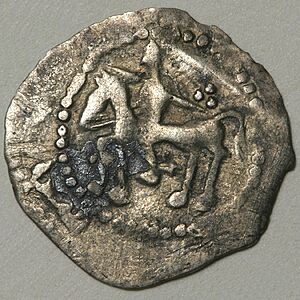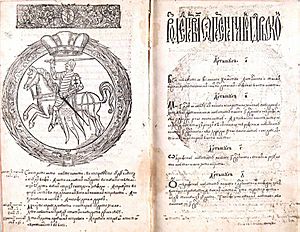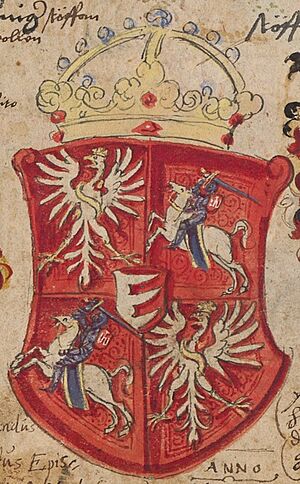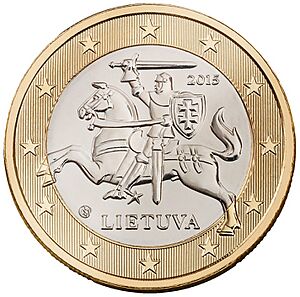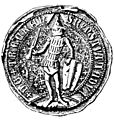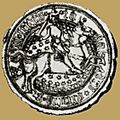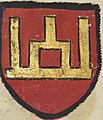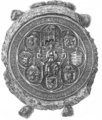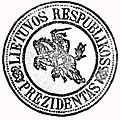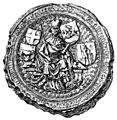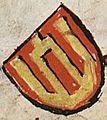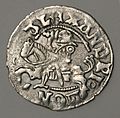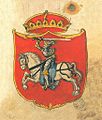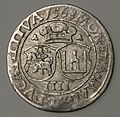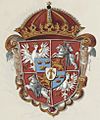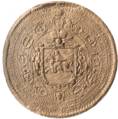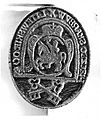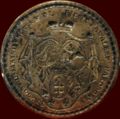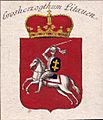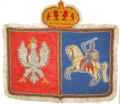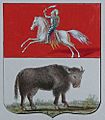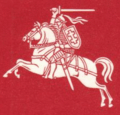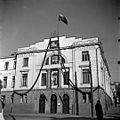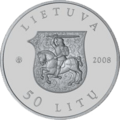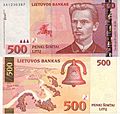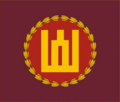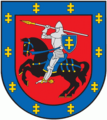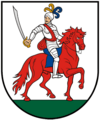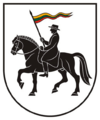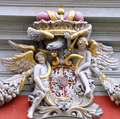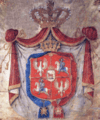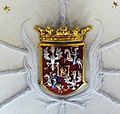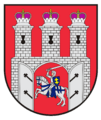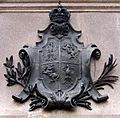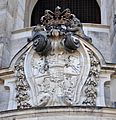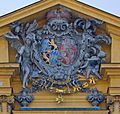Coat of Arms of Lithuania facts for kids
The coat of arms of Lithuania shows a brave knight riding a horse. He wears armour, holds a sword, and carries a shield. The background is bright red. This important symbol is also known as Vytis, which means "the Chaser" or "the Pursuer" in Lithuanian. It has been a symbol of Lithuania for many centuries, showing its history and spirit.
Contents
What is a Coat of Arms?
A coat of arms is like a special symbol or emblem for a country, family, or organization. It's often shown on a shield. These symbols have been used for a very long time, especially in Europe. They help people recognize who someone is or what a group stands for. For countries, a coat of arms represents their history, values, and independence.
The Story of Vytis
The Vytis is one of the oldest coats of arms in Europe. It shows a knight on horseback, ready for battle. This knight represents bravery, strength, and the defense of the homeland. The red background stands for courage and the blood shed for freedom. The silver (white) knight and horse show purity and justice. The golden (yellow) parts of the shield and sword mean nobility and wealth.
Early Beginnings
The Vytis symbol first appeared in the 14th century. It was used by the Grand Dukes of Lithuania, who were powerful rulers. One of the earliest known uses was by Grand Duke Algirdas. His seal from 1366 showed a knight on horseback.
The symbol became very popular during the time of Jogaila and Vytautas the Great. These leaders helped make Lithuania a very large and strong country. The Vytis was on their seals, flags, and coins. It showed their power and the unity of the Lithuanian lands.
Vytis Through History
Over the centuries, the Vytis changed a little in its design. But the main idea of a knight on a horse always stayed the same. It was a symbol of the Grand Duchy of Lithuania. This was a huge state that existed for hundreds of years.
When Lithuania joined with Poland to form the Polish–Lithuanian Commonwealth, the Vytis was still an important symbol. It was often shown alongside the Polish Eagle. This showed that both parts of the Commonwealth were equally important.
Even when Lithuania lost its independence for a time, the Vytis remained a symbol of hope. People kept it alive in their hearts and on secret flags. It reminded them of their past glory and their dream of freedom.
Vytis Today
After Lithuania regained its independence in 1918, the Vytis was officially brought back as the national coat of arms. It was a proud moment for the country. The design was updated to look more modern, but it kept its historical meaning.
Today, the Vytis is everywhere in Lithuania. You can see it on government buildings, official documents, and coins. It is a powerful reminder of Lithuania's long history, its struggles, and its triumphs. It teaches young people about the importance of courage, freedom, and national pride.
The Vytis is not just a picture; it's a story. It tells the tale of a nation that has always fought for its freedom and identity. It inspires Lithuanians to be brave and to protect their country's values.
Images for kids
-
Baltic mythology pagan Gods: Peckols, Perkūnas, Potrimpo
-
Early Lithuanian coin with a joint symbol of a spearhead and a cross that was minted by Jogaila, Vytautas, and possibly Algirdas or Skirgaila
-
Authentic Seal of Duke Kęstutis with Latin words]]
-
The Royal Seal of Supreme Duke Władysław III Jagiellon, which includes a winged Lithuanian Coat of Arms, 1438
-
The Lithuanian coat of arms on an uhlan's hat of the Grande Armée 17th Lithuanian Uhlan Regiment
-
Presidential Seal of the Republic of Lithuania with Vytis, used in 1919–1940
-
Officers and soldiers from the Belarusian Battalion of the Lithuanian Armed Forces in Kaunas, 1921
-
One of the earliest surviving depictions of Vytis (Waikymas) in a flag of Vytautas the Great. Painted in 1416 by a Portuguese herald, who attended the Council of Constance.
-
Seal of Sigismund Kęstutaitis with Vytis in his left hand, 15th century.
-
Duke Sigismund Korybut and his troops flying the Lithuanian coat of arms in Prague, 15th century
-
Vytis with Columns of Gediminas from the 15th-century Codex Bergshammar. Attributed to Grand Duke Žygimantas Kęstutaitis.
-
Lithuanian Denar of Grand Duke Casimir IV Jagiellon with horseman and the Columns of Gediminas, 15th century
-
A 1506 depiction of Grand Duke Alexander Jagiellon in the Polish Senate, surrounded by Lithuanian and Polish coat of arms, one of them are the golden Columns of Gediminas
-
The first page of the Latin copy of Laurentius (1531) of the First Statute of Lithuania. Vytis (Waikymas) is drawn on a damasked shield.
-
A 1568 Lithuanian coin of Grand Duke Sigismund II Augustus with horseman and the Columns of Gediminas
-
Thaler of Grand Duke Stephen Báthory with Vytis (Waikymas) and the Polish Eagle, 1579
-
Coat of arms of the Polish–Lithuanian Commonwealth during the reign of the Vasa dynasty
-
Coin of 15 golden Ducats of Grand Duke Sigismund III Vasa with Vytis (Waikymas), 1617
-
The Great Seal of Lithuania with Vytis (Waikymas) and Columns of Gediminas, belonging to Władysław IV Vasa
-
Golden Lithuanian Ducat of Grand Duke John II Casimir Vasa with Vytis (Waikymas), 1665
-
Coin of Grand Duke John III Sobieski with Vytis (Waikymas) and the Polish Eagle, 1684
-
Thaler of Grand Duke Augustus II the Strong with Vytis (Waikymas), 1702
-
Coin of 10 golden Ducats of Grand Duke Augustus III with Vytis (Waikymas), 1756
-
Relics of the Uprising of 1831, exhibited in the National Museum of Lithuania in Vilnius
-
Coat of arms of the November Uprising, 1830–31
-
The Provisional Government in Warsaw reintroduced Vytis (Pogonia) and Eagle on the coins and banknotes during the 1830–31 November Uprising
-
The White Columns of Vilnius (1818–1840) with Vytis (Pogonia), which were later replaced with the double-headed eagles
-
Coat of arms of Vitebsk from 1781
-
A banknote of 10 Lithuanian litas with Vytis and the Columns of the Gediminids (1927)
-
A banknote of 5 Lithuanian litas with Vytautas the Great and Vytis, 1929
-
A Lithuanian bomber-reconnaissance monoplane ANBO VIII with the Double Cross of the Jagiellonians, constructed by the Lithuanian aeronautical engineer Antanas Gustaitis, in 1939
-
Lithuanian Vickers Light Tanks M1936 with the Columns of the Gediminids, heading to the Lithuanian capital Vilnius in 1939
-
The presidential version of the coat of arms, as depicted on the Presidential Palace, and the Flag of the President of Lithuania
-
Litas commemorative coin featuring a historical Vytis
-
A banknote of 500 Lithuanian litas with Vytis, 2000
-
The Lithuanian soldiers with the Columns of Gediminas during the Battle of Grunwald reconstruction
-
Lithuanian Air Forces aircraft with the Double Cross of the Jagiellonians in 2016
-
Vilnius County coat of arms
-
Vytis (Pogonia) is depicted on one of the Wawel Castle's towers in Kraków, alongside the Polish Eagle and the Double Cross of the Jagiellonians
-
John III Sobieski's coat of arms crowning the Royal Chapel in Gdańsk with Vytis (Pogonia)
-
Vytis (Pogonia) as depicted on the façade of the Collegium Novum of the Jagiellonian University in Kraków
-
Illustration with coat of arms of John I Albert (after 1492)
-
Illustration with coat of arms of Stanislaw August Poniatowski, 1780
-
Wawel, Kraków
-
Guardhouse, Poznań, 1780s
-
Lithuanian Ministry for Belarusian Affairs (Lithuanian: Gudų reikalų ministerija), which existed between 1918 and 1924 in Lithuania
-
Coat of arms of the Kingdom of Galicia–Volhynia, 1313
-
Seal of King Yuri II Boleslav denoting a horseman with lion on the coat of arms (14th century)
-
Iziaslav coat of arms with the Double Cross of the Jagiellonian dynasty
-
Watch tower of Vytautas the Great in Kherson with the historical state flag of Lithuania
-
Adam Mickiewicz Monument, Lviv, 1904
-
Albertina, Vienna, 18th century
-
Catholic church, Nancy, 18th century
-
Vytis on top of Palais de la Cité's Tour de l'Horloge clock, Paris, since 1585
-
Double-Denar of the Duchy of Courland and Semigallia with monogram of Stephen Báthory, coat of arms of Gotthard Kettler, and Vytis (Waikymas), 1578
-
Coin of the Duchy of Courland and Semigallia with portrait of Ernst Johann von Biron, Vytis (Waikymas), and the Polish Eagle, 1764
-
Freiberg Cathedral in Freiberg, Saxony, 18th century
-
Zwinger, Dresden, 18th century
-
Coat of arms on the Palace Übigau with Hercules, Dresden
-
Coats of arms on the Theatine Church in Munich, 18th century
-
Coat of arms on the Walderdorff Palace in Trier, 18th century
-
A Saxon milepost in Lengenfeld, Saxony state
-
A postal milestone in Grimma, Saxony state
-
A postal milestone in Niemegk, Brandenburg state
-
Portal of a post office in Wurzen, Leipzig district, 1734
See also
 In Spanish: Escudo de Lituania para niños
In Spanish: Escudo de Lituania para niños


